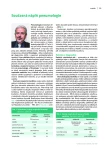Extrinsic allergic alveolitis: minimum for clinical practice
Authors:
Martina Šterclová
Authors‘ workplace:
Pneumologická klinika 1. LF UK a Thomayerovy nemocnice, Praha
Published in:
Vnitř Lék 2017; 63(11): 802-806
Category:
Reviews
Overview
Extrinsic allergic alveolitis (EAA) represent a group of diseases, that develop in susceptible individuals after repeated exposure to usually organic inhalation antigen. Patient may be in contact with these agents both in occupational and in home environment, as well as during free time activities and hobbies. The course of the disease is highly variable – EAA may have dramatic symptoms with fever, cough and severe dyspnoea as well as may be presented with slowly increasing dyspnoea and chronic cough. The more inconspicious are the symptoms of chronic EAA, the more problematic its treatment may be. Treatment options must be sought individually and respect potential risks and benefits for the patient. Avoiding further contact with offending antigens as well as optimizing patients nutritional status and starting pulmonary rehabilitation should be emphasized.
Key words:
corticosteroids – extrinsic allergic alveolitis – environmental exposure
Sources
1. Kateman E, Heederik D, Pal TM et al. Relationship of airborne microorganisms with the lung function and leucocyte levels of workers with a history of humidifier fever. Scand J Work Environ Health 1990; 16(6): 428–433.
2. Greenberg MI, Vearrier D. Metal fume fever and polymer fume fever. Clin Toxicol (Phila) 2015; 53(4): 195–203. Dostupné z DOI: <http://dx.doi.org/10.3109/15563650.2015.1013548>.
3. Merget R, Sander I, van Kampen V et al. Hypersensitivity pneumonitis due to metalworking fluids: how to find the antigens. Adv Exp Med Biol 2013; 788: 335–340. Dostupné z DOI: <http://dx.doi.org/10.1007/978–94–007–6627–3_45>.
4. Chudáček Z. HRCT plic – technika vyšetření, CT anatomie, základní typy patologických nálezů. Med Pro Praxi 2010; 7(6–7): 299–302.
5. Morell F, Villar A, Ojanguren I et al. Hypersensitivity Pneumonitis: Challenges in Diagnosis and Management, Avoiding Surgical Lung Biopsy. Semin Respir Crit Care Med 2016; 37(3): 395–405. Dostupné z DOI: <http://dx.doi.org/10.1055/s-0036–1580692>.
6. Vasakova M, Morell F, Walsh S et al. Hypersensitivity Pneumonitis: Perspectives in Diagnosis and Management. Am J Respir Crit Care Med 2017; 196(6): 680–689. Dostupné z DOI: <http://dx.doi.org/10.1164/rccm.201611–2201PP>.
7. Spagnolo P, Wuyts W. Acute exacerbations of interstitial lung disease: lessons from idiopathic pulmonary fibrosis. Curr Opin Pulm Med 2017; 23: 411–417. Dostupné z DOI: <http://dx.doi.org/10.1097/MCP.0000000000000405>.
8. Kouranos V, Jacob J, Nicholson A et al. Fibrotic Hypersensitivity Pneumonitis: Key Issues in Diagnosis and Management. J Clin Med 2017; 6(6): E62. Dostupné z DOI: <http://dx.doi.org/10.3390/jcm6060062>.
9. Tsutsui T, Miyazaki Y, Okamoto T et al. Antigen avoidance tests for diagnosis of chronic hypersensitivity pneumonitis. Respir Investig 2015; 53(5): 217–224. Dostupné z DOI: <http://dx.doi.org/10.1016/j.resinv.2015.04.003>.
10. Miyazaki Y, Tsutsui T, Inase N. Treatment and monitoring of hypersensitivity pneumonitis. Expert Rev Clin Immunol 2016; 12(9): 953–962. Dostupné z DOI: <http://dx.doi.org/10.1080/1744666X.2016.1182426>.
11. van der Goes MC, Jacobs JW, Bijlsma JW. The value of glucocorticoid co-therapy in different rheumatic diseases – positive and adverse effects. Arthritis Res Ther 2014; 16(Suppl 2): S2. Dostupné z DOI: <http://dx.doi.org/10.1186/ar4686>.
12. Manson SC, Brown RE, Cerulli A et al. The cumulative burden of oral corticosteroid side effects and the economic implications of steroid use. Respir Med 2009; 103(7): 975–994. Dostupné z DOI: <http://dx.doi.org/10.1016/j.rmed.2009.01.003>.
13. Riario Sforza GG, Marinou A. Hypersensitivity pneumonitis: a complex lung disease. Clin Mol Allergy 2017; 15: 6. Dostupné z DOI: <http://dx.doi.org/10.1186/s12948–017–0062–7>.
14. Solaymani-Dodaran M, West J, Smith C et al. Extrinsic allergic alveolitis: incidence in the general population. QJM 2007; 100(4): 233–237.
15. Morisset J, Johannson KA, Vittinghoff E et al. Use of Mycophenolate Mofetil or Azathioprine for the Management of Chronic Hypersensitivity Pneumonitis. Chest 2017; 151(3): 619–625. Dostupné z DOI: <http://dx.doi.org/10.1016/j.chest.2016.10.029>.
16. [American Thoracic Society]. Idiopathic pulmonary fibrosis: diagnosis and treatment. International consensus statement. American Thoracic Society (ATS), and the European Respiratory Society (ERS). Am J Respir Crit Care Med 2000; 161(2 Pt 1): 646–664.
17. Lota HK, Keir GJ, Hansell DM et al. Novel use of rituximab in hypersensitivity pneumonitis refractory to conventional treatment. Thorax 2013; 68(8): 780–781. Dostupné z DOI: <http://dx.doi.org/10.1136/thoraxjnl-2013–203265>.
18. Kosina P, Rumlarová Š. Vakcinace u imunokompromitovaných osob. Remedia 2014; 24(5): 363–369.
Labels
Diabetology Endocrinology Internal medicineArticle was published in
Internal Medicine

2017 Issue 11
Most read in this issue
- Spirometry – basic examination of the lung function
- Non-invasive ventilation
- Small-cell lung cancer: epidemiology, diagnostics and therapy
- Pneumonia in immunocompromised persons
